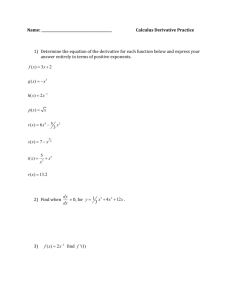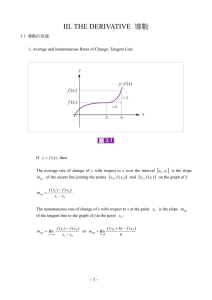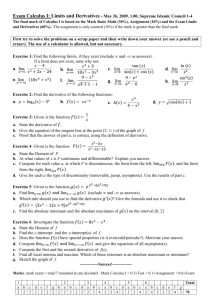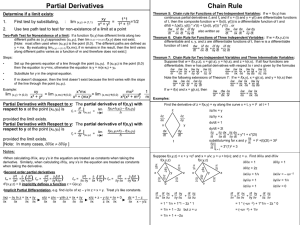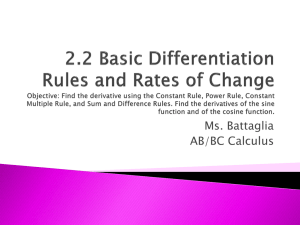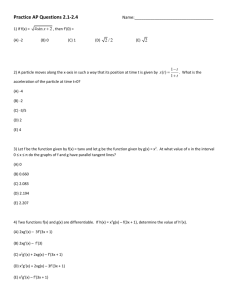Calculus 140, section 3.2 Differentiable Functions
advertisement
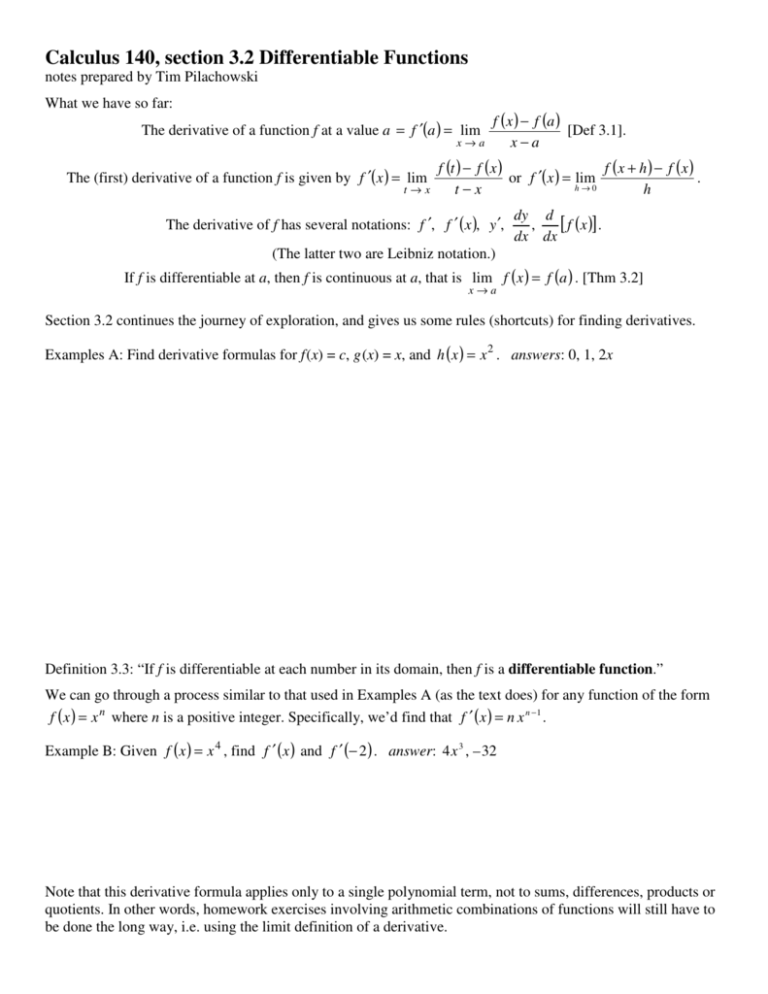
Calculus 140, section 3.2 Differentiable Functions notes prepared by Tim Pilachowski What we have so far: The derivative of a function f at a value a = f ′(a ) = lim x→a The (first) derivative of a function f is given by f ′( x ) = lim t→x f ( x ) − f (a ) [Def 3.1]. x−a f (t ) − f ( x ) f (x + h ) − f (x ) or f ′( x ) = lim . h→0 t−x h The derivative of f has several notations: f ′, f ′ ( x ), y ′, dy d , [ f (x )] . dx dx (The latter two are Leibniz notation.) If f is differentiable at a, then f is continuous at a, that is lim f ( x ) = f (a ) . [Thm 3.2] x→a Section 3.2 continues the journey of exploration, and gives us some rules (shortcuts) for finding derivatives. Examples A: Find derivative formulas for f (x) = c, g (x) = x, and h ( x ) = x 2 . answers: 0, 1, 2x Definition 3.3: “If f is differentiable at each number in its domain, then f is a differentiable function.” We can go through a process similar to that used in Examples A (as the text does) for any function of the form f ( x ) = x n where n is a positive integer. Specifically, we’d find that f ′ ( x ) = n x n −1 . Example B: Given f ( x ) = x 4 , find f ′ ( x ) and f ′ (− 2 ) . answer: 4x 3 , – 32 Note that this derivative formula applies only to a single polynomial term, not to sums, differences, products or quotients. In other words, homework exercises involving arithmetic combinations of functions will still have to be done the long way, i.e. using the limit definition of a derivative. What about some less prosaic functions? For Examples C and D, we’ll use the alternate version of the first derivative formula. f ′( x ) = lim t→x f (t ) − f ( x ) f (x + h ) − f (x ) f (x + h ) − f (x ) = lim = lim ( x+ h ) → x (x + h ) − x h→0 t−x h Examples C: Find the derivatives of y = sin x and y = cos x. Note that these derivative formulas apply only to the two basic trigonometric functions given, not to sums, differences, products or quotients. In other words, homework exercises involving arithmetic combinations of functions will still have to be done the long way, i.e. using the limit definition of a derivative. Example D: Find the derivative of y = e x . The natural exponential function is the only function which is its own derivative. Note that this derivative formula applies only to the natural exponential function, not to sums, differences, products or quotients. In other words, homework exercises involving arithmetic combinations of functions will still have to be done the long way, i.e. using the limit definition of a derivative. Some functions are not differentiable over their whole domain, but rather on a portion (i.e. interval) within the domain. The text gives full explanations of “differentiable on an open interval (a, b)”, “differentiable on a closed interval [a, b]”, and “differentiable on a closed unbounded interval [a, ∞) or (– ∞, b]”. Essentially, the definitions involve a function being differentiable at every value in the interior of an open interval, with onesided limits existing at closed endpoints. Look over the text’s Example 4 which demonstrates that while y = x has a domain of [0, ∞), it is differentiable only on the open unbounded interval (0, ∞). Last concept for section 3.2: functions that are increasing or decreasing on an interval. “f is increasing on I if f ( x ) < f ( z ) whenever x and z are in I and x < z. “f is decreasing on I if f ( x ) > f ( z ) whenever x and z are in I and x < z.” For our purposes, we’re interested in what these tell us about the slope of the tangent lines, i.e. the value of the first derivative. f (z ) − f (x ) > 0 , since both numerator and denominator will have z−x f (z ) − f (x ) the same sign, positive or negative. If f is differentiable on I, f ′( x ) = lim ≥ 0 for all values of x in I. z→x z−x If f is increasing on an open interval I, then f (z ) − f (x ) < 0 , since numerator and denominator will have z−x f (z ) − f (x ) opposite signs, one positive and the other negative. If f is differentiable on I, f ′( x ) = lim ≤ 0 for all z→x z−x values of x in I. If f is decreasing on an open interval I, then See the text’s Example 5 for an example of determining intervals on which a function is increasing and decreasing.
